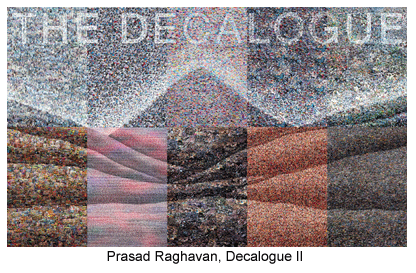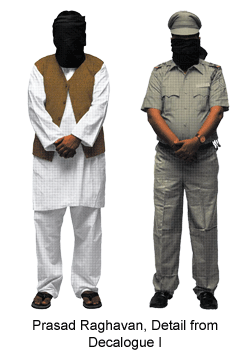New Media
Debating the New in New Media Art
What is new in new media art? Each epoch in art history has created its own new mediums and with such advents art has considerably gained in innovating new forms and in ging forward with added energy. Scientific experiments and inventions have always been a part of artistic process. Hence, it would not be fallacious to believe that each epoch has its own new media and there for its own 'new media art'. However, of late we have developed this tendency to call anything that implements the latest technology as a tool to produce art as 'new media art'. It is not that there is no grain of truth in it. There is, but a deeper look would disprove its own claims as we know well that a new technology is going to replace the existing ones sooner than later.
What makes the current enthusiasm for new media art a bit fashionable and a bit covetable? For me, this overt passion for new media art comes from art's own imaginary restrictive rules. During our modern times, art was taken for something that was purely subjective and existential. It used scientific notions only up to that extent where analysis became handy tool  for explicating existential and political dilemmas. The isms developed during the first half of the 20th century would tell you how scientific notions were appropriated for existential purposes.
for explicating existential and political dilemmas. The isms developed during the first half of the 20th century would tell you how scientific notions were appropriated for existential purposes.
New media art, though the nomenclature was not even nascent at that point of time, became a reality during 1960s and the decades that followed. It was Andy Warhol who really caught the spirit of Duchampian proposals and used scientific inventions for generating his kind of art. Conceptual art that followed the Warholian orgy made use of scientific innovations considerably. New media art as a special category developed from these conceptual meanderings as the artists involved in the scene could realize the potential of science and technology to proliferate the artistic ideas not only as a medium but as a message itself.
Today, 'New Media Art' is attributed as a qualification to such kind of art, which could be called 'post-video phase' art. Video, with its inclusion in the establishments as an accepted art language, the so called new media art still shows the potential of operating from outside the galleries and museums. They can happen in any place, from a street corner to a call centre, from an artist's studio to a science lab, to a community centre to forest land. It could be transferred and transmitted with and without wires, it could be seen in the internet space or even in your iPads. It can come with or without visuals, it can come with or without sound, it can come to you as in pure sonic waves. And finally, it can be seen/heard/interacted in a gallery space also.
New Media Art is a kind of art that uses new media as medium or the kind of art that use new media as message. Technology is the in thing and the multi-disciplinary approach is what makes new media art practice possible. Any thing that looks apparently scientific need not necessarily be a specimen of new media art. For instance, an image produced out of digital modes using the latest computer software available in the market need not fundamentally be a new media art, whereas a work of art that uses oil colors and incorporates computer software to make it interactive in someway could be a new media piece. All sounds produced in a mixing console need not necessarily be a piece of sonic art but a sound produced inside a well and transmitted to the public through satellite or some other implements could be a new media sonic piece (as in Sonia Khurana and Yoko Uno).
Reviving certain old methods of making art and giving it a new value and vision vis-à-vis the new technique used for the revival could be considered within the rubric of new media parlance. I would like to cite the work titled 'Decalogue', a series done by Delhi based artist Prasad Raghavan in this context.  In 'Decalogue I' Prasad uses high precision silkscreen printing technique to produce ten panels in which you see the images of ten characters from our quotidian urban life.
In 'Decalogue I' Prasad uses high precision silkscreen printing technique to produce ten panels in which you see the images of ten characters from our quotidian urban life.
The hooded images of ten people (enacted by two actors) are done on canvas of 4' x 8' size each. The method used is conventional screen printing. But using sophisticated paints and precision visual transference method, Prasad creates a series of images, which are as good as digital prints. Why does Prasad do something like that when digital image transfer is easily available in our country? For Prasad, formally speaking, it is a way of addressing a popular medium of yester years, currently done to death by over use. He revisits the same medium with newer techniques and creates an effect, which is akin to the results of digital imaging. Through this act, Prasad connects a craft/art oriented conventional medium (which was very new and fashionable when Andhy Warhol used it) to the new technology and proves that the possibilities of any medium to grow beyond its own set limitations and definitions are immense.
However, Prasad uses digital imaging in his 'Decalogue II' in an attempt to see how a new medium could be implemented to create something to the effect of a conventional piece of art. In this huge work of ten panels, when seen together present before the audience the image of Mount Sinai from where Moses read out the Ten Commandments to his tribe. If you look closely, you could make out that how the artist has created each panel with millions of images that are available in the public domain in the form of advertisements, magazine and newspaper pictures and photographs. These are painstakingly arranged using the computer software to create the effect of a painting. Here what Prasad wants to convey is the counter thesis of using the new medium to forward a message in itself. For him the images that constitute Mount Sinai are the images from a consumerist society that uses new media to produce images as well as consumerist products.
Through the interfacing of two methods of new media, Prasad creates a new context for addressing the validity of this term, 'New Media Art'. The examples given here show us that it is not just the new media as 'new media' creates new media art, but the art that is created out of new media, even if it consciously intervenes in the process of linking up the conventional and the cutting edge art forms. Therefore, in my observation, New Media Art has to be put against a larger and wider horizon of innovative technologies and debated rather than celebrating it as something extremely new and unprecedented.
JohnyML
Tags: art






